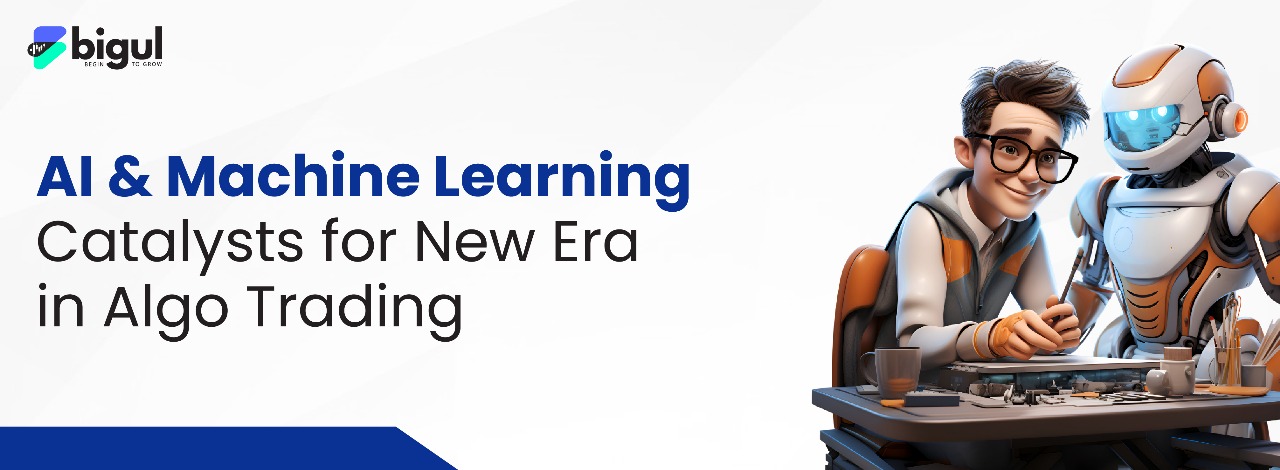With the rise of technology and large volumes of data, the demand for speed, efficiency, operation, and precision has never been so related within the different paradigms. Algorithmic trading has begun to rely much on artificial intelligence (AI) and machine learning (ML) technologies. They are capable of processing huge volumes of data in real-time.
Through them, unseen patterns can be detected, trading strategies can be optimized and risks can be regulated better than ever before. Beyond enhancing decision-making, they can make automated trading systems better, offer tailor-made financial advice via robo advisors and chatbots, and even assess market sentiment and risks with incredible accuracy.
This Article examines the transformative nature of AI and ML in algorithmic trading, including advantages for traders and investors and challenges faced today.
Prior to going further into how Artificial Intelligence (AI) and Machine Learning (ML) are transforming algorithmic trading, let these main terms be defined.
Also Read | Algo trading: How It Works, How To Start, And What Are The Pros and cons of Algo Trading
Definitions
Algorithmic Trading (Algo Trading): Placing an order through pre-decided pre-programmed instructions to automatically deal, based on certain variables including time, price, and volume. The Securities and Exchange Board of India (SEBI), - an Indian regulatory body that regulates the securities market - has defined this term in its Circular No. CIR/MRD/DP/09/2012 dated 30 March 2012, as "Any order generated on the basis of automated execution logic shall be referred to as algorithmic trading."
Artificial Intelligence (AI): It is technology that allows computers and machines to simulate human learning, knowing, problem-solving, decision-making, creativity, and autonomy. It assists business in processing vast amounts of data, predicting market trends, and making real-time strategic decisions.
Machine Learning (ML): It is a method of getting computers to learn through experience so that they can make smart decisions by themselves. It is a part of AI and is used in trading to analyze historical and current data, find patterns and modify strategy based on the market.
Machine Learning For Algo Trading:
Algorithmic trading is being revolutionized by Machine learning (ML) by facilitating algorithms to create smart data-driven decisions. Machine learning programs can learn incrementally from incoming data, realign themselves based on evolving marketplace conditions and get better continuously without the aid of humans.
1. How Machine Learning Enables Algorithmic Trading
• Data-Driven Decision Making: Machine learning algorithms are driven by huge quantities of data—market prices, volumes, macroeconomic information and news sentiment. By studying this data, ML algorithms can detect patterns and correlations that would be impossible for humans. This enables the traders to make decisions and predict events based on past facts, trends within the market and current events.
• Predictive Modeling: Predicting future market trends is the second major advantage of ML in algo trading. Out of statistical models like regression analysis, neural networks, and time series analysis, machine learning models can make future predictions regarding price movements, arbitrage opportunities and volatility probability in markets. All of the above forecasts become more accurate as the model continually optimizes and learns from the new data sets for future projections. That means that if the market conditions keep swinging and always changing, the demands of the trading style. instantaneously push for adaptability. While fixed programs operate only according to pre-defined rules, ML models can dynamically adjust based on new input at will. This flexibility proves helpful in volatile or uncertain markets because the model can continue to adjust to limit risk or capitalize on upcoming opportunities.
• Risk Management: Machine learning is applied to risk management as well by analyzing the market situation and then regulating trading positions. For instance, ML models can be trained to examine the risk of a trade based on past performance, market volatility and others. This enables the algorithm to adjust the size of the trade or stop losses accordingly, hence protecting the investor from unexpected movement of the market.
2. Applications of Machine Learning in Algorithmic Trading:
The initial step involves collecting huge historical and real-time data in terms of market price levels, volume of trade, and chosen sets of economic data. The data will then be cleaned, normalized, and reshaped for analysis. At last, machine-learning algorithms, such as decision trees and random forest and neural networks, are trained on the preprocessed datasets so that these algorithms would be able to internalize various patterns and correlations.
The trained models are then tested on new, unseen data to check the model performance and the accuracy of such models. Finally, during the stage of deployment, the best models have provided functionality in live trading environments to generate buy and sell signals based on real-time market data.
3. Types of Machine Learning Models Employed for Algorithmic Trading
• Supervised learning: It is an algorithm trained on labeled data, i.e., historical market data with known outcomes, e.g., the value of a stock or direction of the market. The model uses known patterns to make predictions in the future. For example, the model can use a supervised learning algorithm to forecast stock price in a future trading session using different factors pertaining to historical price action, volume, etc.
• Unsupervised learning: It is employed when the algorithm is given the data without being aware of their results. The algorithm identifies hidden patterns or relationships within the data. In finance, the unsupervised learning can be applied to clustering stocks based on similar patterns of behavior, outliers or anomalies in the market or finding novel trading strategies no one has ever thought of before.
• Reinforcement Learning: It is unique in that it figures things out through trial and error. In this paradigm, the algorithm makes a choice (purchasing or selling stocks) and receives feedback based on whether the choice was successful or not. Over time, the algorithm determines the most rewarding action to take and adapts its strategy.
Reinforcement Learning is best applied to high-frequency trading and market-making, where quick and effective decision-making is needed.
Using Chatbots and Robo-Advisors to Revolutionize Algo Trading
Algo-trading chatbots and robo-advisors based on artificial intelligence are revolutionizing algorithmic trading more with process automation, enhanced customer experience and improved, more efficient trading decisions. The technologies are changing the face of finance by facilitating the adoption of more advanced, data-driven trading strategies. AI systems make decision-making easier through the offering of real-time information and auto-execution of trades, boosting efficiency and accuracy. With the development of these technologies, their application in the trading environment enables greater operational efficiency and secure trading results. Yet with these developments, there are risks and challenges attached, which have to be carefully managed to get the best out of them. The following two paragraphs explore some of these aspects in detail, highlighting how these technologies are shaping the future of trading in a fast-paced, technology-driven market.
1. AI-Powered Chatbots: Leveraging Customer Engagement and Market Insights
AI chatbots for customer service are changing the customer care in the whole financial sector through live support, market knowledge and deal support. AI-based chatbots provide instant response to questions, guide trading and update traders about the current going-on of markets - something ordinary chatbots employed in customer support cannot match. For example, Tiger Brokers use their artificial intelligence-based chatbot called TigerGPT to assist clients according to advanced market information and investment guide for rational choices.
2. Machine Learning Based Investment Strategy Automation in Robo-Advisors
Machine learning algorithms are being employed by robo-advisors to revolutionize investment portfolio management, Robo-advisors offer personalized investment advice depending on the risk tolerance and investment goals of a person. Robo-advisors are capable of managing portfolios, rebalancing asset allocation and executing trades with lesser human intervention, thus saving costs and improving efficiency. Goldman Sachs and JPMorgan are some institutions that have incorporated robo-advisors in their products, providing customers AI-based strategies and insights.
AI in Decision-Making: Faster and More Precise Study of The Market
AI platforms are capable of a variety of options from market fundamental analysis to technical analysis. Recent cumulative world events have only added to the already plausible utility of these systems. While some systems enabled traders to see market trends and patterns that were just beginning, AI systems assist a more global and high-end decision-making process that would never have been possible without them. With the continual evolution of introducing new market information, AI-based tools are able to produce more accurate forecasting on expectations and products leading to better choices and speeding up the trading process compared to a human trader.
Risks and Challenges of AI in Trading Systems
While AI-based systems show immense benefits, they also include a number of risks. Over-reliance on computer programs can lead to more instability in the market, particularly at sudden market events when AI might not adjust as fast as necessary Concerns such as data bias, privacy, and lack of transparency in AI algorithms might Adversely affect both the precision and reliability of AI-driven instruments. Therefore, managing these risks becomes critical as such instruments grow their embeddedness into the trading mechanisms.
AI For Sophisticated Pattern Recognition in Algorithmic Trading
AI has been the most revolutionary in algorithmic trading on the back of the capabilities that analytic pattern recognition provides. AI systems are capable of processing huge amounts of data and plotting very complex patterns and trends, enabling better and well-informed trading decisions.
1. AI-Based Chart Pattern Detection
Tools like ChartPatterns.ai use artificial intelligence for financial chart analysis, detecting 16 chart patterns..Analysing images of graphs, the computers are capable of identifying patterns that could indicate a possible trading opportunity, guiding traders on making decisions based on information
2. Machine Learning in Algorithmic Trading
One of the sub-domains of AI, machine learning plays a central role in algorithmic trading that utilizes historical and current information to infer patterns and forecast trends of the market. The approach has space to develop adaptive trading rules that are capable of modifying themselves in congruence with the dynamic behavior of the market.
3. Sentiment Analysis for Market Forecasting
AI incorporates sentiment analysis to create market trends with the analysis of financial reports, social media, and news feeds Natural Language Processing (NLP) technology scans the stock, commodity, or market sentiment and assists in predicting direction for the market and in adapting trading strategies accordingly. They all indicate the role AI is playing in shaking up trading by applying enhanced pattern recognition, enabling dynamic strategies, and enabling better understanding of market sentiment.
AI For Risk Assessment and Market Prediction in Algorithmic Trading
The face of algorithmic trading is being changed by Artificial Intelligence (AI) and Machine Learning (ML) through enhanced risk analysis and sentiment analysis. These tools enable traders to filter out huge amounts of data, identify trends, and make better-informed choices with greater accuracy.
1. Trading Risk Analysis using AI
AI enhances risk management in trading by analyzing past and existing data to determine potential risks and optimize trading strategies. Some of the most effective AI-based techniques are:
• Algorithmic Trading: AI automatically places the trade according to parameters set, with minimum human intervention and bias eliminated.
• Portfolio Optimization: Depending on investors' risk appetite and financial goals, AI compares various assets to create portfolios.
• Machine Learning Risk Monitoring: AI can verify any unusual activity and remove risks beforehand. In the near future, AI-driven risk management will also tap into alternative data sets, develop machine learning models, and use natural language processing to enhance market sentiment analysis.
2. Market Prediction using Sentiment Analysis
Sentiment analysis combined with algorithmic trading offers market sentiment insights by using news, social media, and financial reports' analysis. The AI programs with sentiment analysis capability can measure people's sentiment in numbers, thus allowing traders to forecast changes in the market and adjust accordingly. For example, analyzing statements of central banks is able to generate conservative economic outlooks thereby causing traders to rebalance before possible market decline.
The capacity of artificial intelligence to parse and evaluate unstructured data across different sources promotes predictive modeling as well as risk management, yielding a competitive advantage for traders operating in an unpredictable market.
Why AI/Ml is A Better Approach To Trade
Here are some ways that AI/ML can be used to help trading:
Trend Identification: AI/ML can consider so much market data and pick out patterns that might be missed by humans.
Smarter Guesses: Through processes of going over a great amount of data points, AI/ML can put together smarter-educated guesses on the direction of the market.
Improved Planning: AI/ML allows the traders to test plans using historical data and how well these were executed.
Scalability: AI/ML systems can scale up or down depending on market conditions.
24/7 Market Watch: AI/ML never sleeps, but traders do.
Fast Moves: AI/ML systems can execute trades very fast.
Auto Trading: AI/ML can execute trades in accordance with pre-programmed strategies.
Improved Risk Management: AI/ML helps traders manage risks by tracking the market and adjusting plans.
Lack of Emotional Bias: Emotional decisions can destroy trades. AI/ML systems don't get emotional; therefore, they make more impartial decisions.
Improved Trade Execution: The execution of trades by AI-ML is smooth, hence there are possibilities of less slippage and better execution.
Follow the Rules: AI-ML would assist traders to follow the rules and regulations, to avoid money laundering, keep to KYC regulations, etc.
Always Improving: The greatest thing about AI/ML is that it learns from previous trades and adjusts according to changes. The more it sees, the smarter and better it becomes.
Big boost to traders: These platforms provide more advanced data analysis, quicker trades, great risk handling, and no emotional influences. This makes trading much more stable and efficient. With that, AI-ML also provides growth with constant market monitoring and strategy alterations, which are key essentials when working within this sophisticated context.
Challenges and Limitations of Machine Learning in Algorithmic Trading
Machine Learning (ML) is the greatest asset in algorithmic trading. There are several limitations and obstacles which must be overcome by traders to make their models reliable and effective.
Data Quality and Availability
For ML models to operate successfully, they need access to high-quality and appropriate data. Unexplained and auditable models may arise fears regarding the underlying risks and concerns over the desired level of trust. Machine learning models have to comply with certain regulatory obligations, including, but not limited to, a guarantee of transparency, explainability, and fairness. Because financial markets are highly regulated environments, any trading algorithm also has to adhere to transparency and reporting regulations. ML model complexities might involve issues of compliance with such regulations, especially if they are not explainable. In spite of the above problems, machine learning goes on to transform algorithmic trading by providing the capacity to develop more efficient, precise, and high-performing trading strategies.
With the right mix of resources and data, traders can be able to leverage ML to their advantage in advanced markets, aided by enhanced decision-making and optimal performance of the systems used to trade their commodities.
Model Interpretability and Complexity
Some advanced ML models, especially deep networks, are "black boxes."Being transparent-free complicates decision-making explanations to the traders. It could be an outright drawback to some traders, particularly those intent on exercising distinct control and scrutiny, to find that they are not able to understand how a model reaches decisions. Nonexplainable and explainable ones could raise concern regarding risks and trust issues.
Regulatory Compliance
Machine learning models must address regulatory requirements, which are traditionally transparency, explainability, and fairness. Due to the tightly regulated nature of financial markets, any trading system has to comply with transparency and reporting regulations. Complexity in ML models can create difficulty in ensuring compliance with such regulations, particularly if they are not interpretive.
In spite of all these challenges, ML is transforming algorithmic trading by giving the means to create more precise, efficient, and effective trading strategies. Given the right data, resources, and precautions, ML supplies traders with a competitive edge to make better decisions and enhance performance on befuddling markets.
Conclusion
Machine Learning (ML) and Artificial Intelligence (AI) are vastly changing the algorithmic trading environment. Through these technologies, (1) decision-making is improved, (2) risk management is most efficiently executed, and (3) traders and investors are well equipped to have a competitive edge. The use of these technologies does, however, come with a fair share of challenges: data quality, model complexity, and regulatory compliance. Despite these constraints, the future role that AI and ML are likely to take is one that cannot be taken lightly; as they will ever wider open doors for choice investors, traders, and stand as cornerstones for accomplishing sounder investment in the financial markets. AI and ML manifestly permit trend recognition and pattern identification.
Also Read:
- Is Algorithmic Trading Safe for Investors
- Top Algo Trading Software for Beginners
- Start Algo Trading Using Python | Complete Guide by Bigul
- Mastering Algo Trading: Strategies for Success in Automated Trading









.jpg)
.jpg)
